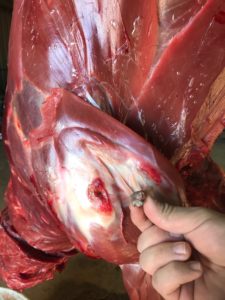 In our last post, we reported that the Minnesota Department of Agriculture found that some 7% of the venison donated to shelters has some level of lead contamination from bullets. If this issue concerns you, the Minnesota DNR offers these tips, which are relevant anywhere in the country.
In our last post, we reported that the Minnesota Department of Agriculture found that some 7% of the venison donated to shelters has some level of lead contamination from bullets. If this issue concerns you, the Minnesota DNR offers these tips, which are relevant anywhere in the country.
ENJOY YOUR HUNT Get out. Have fun. Nothing in the DNR’s lead bullet fragmentation study suggests you shouldn’t go deer hunting.
TAKE LEAD EXPOSURE SERIOUSLY Pregnant women and children under six should never be placed in a situation where they could ingest lead particles. That’s because pregnant women and younger children are especially sensitive to lead exposure. They absorb most of the lead they take in, and the brains of infants and young children are still developing. Lead bullets fragments are too small for you to detect by sight, touch or while chewing.
LEAD IN VENISON HAS NOT BEEN LINKED TO ANY ILLNESSES That’s the good news. Still, it is a neurotoxin whose toxicity depends on the level and frequency of exposure. Lead can have physiological effects on human bodies and brains at levels below that which would cause any noticeable signs of sickness. Do not (eat) deer with excessive shot damage.
BULLET SELECTION CAN MINIMIZE YOUR EXPOSURE TO LEAD The shotgun slug and muzzleloader bullet left less lead in an animal than commonly used high-powered soft-point or rapid expanding bullets (in the Minnesota study). The soft-point bullet and rapid expanding ballistic tip bullet fragmented the most, the latter leaving an average of 141 fragments at an average maximum distance of 11 inches from the wound channel. The bonded-core bullet came in third in number of fragments. The bullet with the lead completely enclosed in copper at the rear of the bullet averaged only nine copper fragments. The copper bullet fragmented very little.
SHOT PLACEMENT CAN MINIMIZE EXPOSURE TO LEAD The study showed that a shot into the hind-quarters, where heavy bones are located, will result in high and widespread fragmentation in the meatiest part of the animal. Hunters need to choose their shots wisely and maintain their marksmanship skills.
TRIM LIBERALLY AROUND THE WOUND CHANNEL If you process your own deer, trim liberally around the wound channel. There is no definitive answer to how much additional meat you need to discard to ensure that no random lead particles remain. However, be aware that lead particles were found as far as 18 inches away from the wound channel in the DNR’s study.
GROUND VENISON TENDS TO CONTAIN THE MOST LEAD During the past year the Minnesota Department of Agriculture tested 1,029 packages of commercially ground venison and found that 26 percent of those packages contained lead fragments. They tested 209 packages of whole muscle cuts and found 2 percent contained lead fragments. Test results from a limited sample of hunters who processed venison at home showed similar results.
ULTIMATELY THE DECISIONS ARE YOURS The DNR conducted its lead fragmentation study so it can provide hunters with information on which they can make informed choices. We hope you review our results, take appropriate precautions, and continue to enjoy venison, which is a great source of protein.






